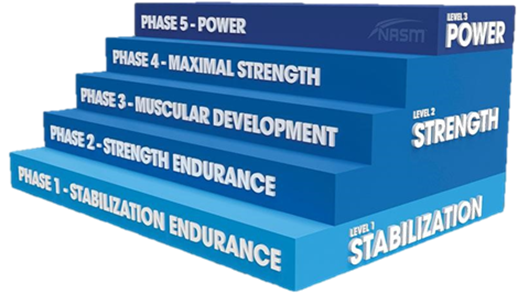By ANDRE ADAMS
If you’re looking for an exercise program to help you effectively build mass, you may be looking for something to do with hypertrophy training. Similar to classic strength training, the goals of hypertrophy are different. One focuses on building strength and the other on building muscle mass.
Hypertrophy is defined as “the enlargement of skeletal muscle fibres in response to being recruited to develop increased levels of tension, as seen in resistance training. [It] is characterized by an increase in the cross-sectional area of individual muscle fibres resulting from an increase in myofibril proteins (myofilaments).”
The specific Adaptation to Imposed Demands (SAID) Principle states that adaptations are specific to the imposed stimulus. General Adaptation Syndrome (GAS) by Hans Selye describes the pattern of responses that the body goes through after being prompted by a stressor. If the demand is not placed on the muscle over time the muscle will begin to atrophy.
WHAT IS HYPERTROPHY?
Research indicates that performing approximately 15-20 sets of challenging hypertrophy exercises per week is the optimum stimulus to enhance muscle size. Since maximal muscle response is achieved through 5-6 sets of a specific exercise, it is best to spread the workload throughout the week.
This means that training beyond the maximal growth stimulus you will disrupt the stimulus-recovery-adaptation (SRA) curve by delaying the recovery phase, which is counterproductive to muscle growth. The SRA curve is directly affected by the exercise selection, time, muscle damage, nutrition and client recovery capability.
First, consider a variety of different exercises. Since muscle damage is a function of loading and tension, high tension and high damage exercises will require more time for recovery. These exercises will also stimulate stronger muscle adaptations that will effectively enable it to withstand more tension in subsequent training.
For example, doing five sets of heavy bench presses will cause far more muscle breakdown than 5 sets of pushups. High-tension and high-damage exercises, therefore, require more recovery time but cause greater adaptation. Exercises featuring an increased range of motion, more time under tension, a greater load, and a longer eccentric portion are typically the preferred stimulus to maximize muscle hypertrophy.
Muscle Hypertrophy is also a function of Maximal Voluntary Isometric Contraction (MVIC) and loading/unloading. In other words, the more muscle fibre you can activate through a specific exercise and loading, the greater the demand (stimulus) and therefore the greater the hypertrophy response.
MECHANISMS FOR HYPERTROPHY & MUSCULAR DEVELOPMENT
1) EXERCISE-INDUCED MUSCLE DAMAGE
During eccentric activity, the contractile elements (actin and myosin) in working muscles exert a resistance action that produces small tears in both the contractile elements and surface membrane (sarcolemma) of the associated muscle fibres. The subsequent muscle repair (recovery) strengthens the tissue to protect against further damage (adaptation).
2) METABOLIC STRESS
Metabolic stress results from the buildup of various metabolites (e.g., lactic acid, inorganic phosphate, etc.), primarily because of training in the fast glycolytic energy system where carbohydrates are used anaerobically to fuel performance.
3) MECHANICAL TENSION (FORCE)
Refers to the amount of force/tension within the muscle fibres in response to a static or dynamic stimulus. The reaction increases protein synthesis and muscle size. The goal is to activate as many muscle fibres as possible to maximize the response.
4) FASCIA STRETCH TRAINING
Pumping specific muscle groups full of oxygenated blood in a relatively short period of time forces the fascia tissue to stretch and expand like a balloon. This packs nutrient and oxygen-rich blood into and around the muscle cells to promote repair and growth.
HOW TO TRAIN FOR HYPERTROPHY – REP RANGES AND SETS
Hypertrophy/Muscular Development training is typically moderate-heavy loading (75-85% 1RM),6-12 reps, 2-0-2, 0-60 or 0-30 rests, 3-6 sets (up to 7), 2-4 Strength exercises per body part.

 Sets – The volume of sets can be modified over time as your training progress. Starting out, try shooting for 3 sets of a few different exercises for each major muscle group (or complex movements). For intermediate lifters, increase your set volume to 4-6 sets. For advanced lifters or athletes, it is common to see as many as 6-7 working sets per exercise.
Sets – The volume of sets can be modified over time as your training progress. Starting out, try shooting for 3 sets of a few different exercises for each major muscle group (or complex movements). For intermediate lifters, increase your set volume to 4-6 sets. For advanced lifters or athletes, it is common to see as many as 6-7 working sets per exercise.
Reps – Similar to sets, reps are an opportunity to manipulate training volume. For strength hypertrophy, 6-12 reps with moderately heavy loading 75-85% 1RM are most effective.
For the best all-around workout, I recommend pyramiding up in weight over the course of your working sets. This will maximize hypertrophy and still work the high and low end of the spectrum.
Force – Loading (%1RM)
Time Under Tension (TUT) – Length of time the muscle stimulus creates tension
Cadence – This is the timing of your concentric and eccentric motions during a lift. This can vary depending on the specific goal. For example, stability and strength-endurance type of exercises may use a 4/2/1 (seconds) tempo (eccentric/isometric stabilization/concentric) whereas the typical cadence for hypertrophy training is 2/0/2.
Rest Intervals – Another often overlooked acute variable is rest intervals. This refers to the rest between sets. For most training, 0-60 seconds is sufficient to replenish 85 to 90% of ATP and PC and keep your muscles pumped up. For strength endurance and stabilization, 0-90 seconds is recommended. If you are training for maximal strength/powerlifting, be sure to rest 3-5 mins between sets to ensure your system is fully recovered.
VERTICAL VS HORIZONTAL LOADING:
There are several different ways to execute your hypertrophy training. Horizontal loading is the most common. In horizontal loading, each exercise or muscle group is completely trained before moving on to the next exercise. Vertical loading is often seen in circuit training when each circuit is comprised of a sequence of back-to-back exercises. (i.e., chest press > squats > rows, repeat). Both have benefits and serve different purposes.
For most hypertrophy training and those chasing the pump, horizontal loading is usually the best to keep the specific muscle(s) flooded with oxygenated blood and nutrients and maximize tension.
PROGRESSIVE OVERLOADING:
Remember, your body is always in a state of adaptation. If you want to improve your cardiovascular performance and VO2 threshold, you will want to stress and challenge that area of the nervous system. If you want to improve your maximal strength (i.e., Powerlifting), you will need to train low reps, heavy loads to create that specific adaptation. The key is to shift training phases every 3-4 weeks (or as needed) to create muscle confusion and force your body to continuously adapt to the stress placed upon it.
A decrease in loading (unloading) over an extended period can cause muscle atrophy – a loss in skeletal muscle mass and strength. With consistent training, the body will adapt to the progressions and meet the demands of the stress placed upon it.
*Note that mechanisms such as progressive overloading allow you to remain in a specific phase (i.e., Hypertrophy/Muscular Development for bodybuilding) for longer periods without risking a plateau.
NUTRITION TIPS TO MAXIMIZE HYPERTROPHY FOR MUSCULAR DEVELOPMENT:
The ideal time for a pre-workout meal is usually 60-90 minutes prior to lifting. The ratio of pre-workout meal macronutrients should be carbohydrates, protein, and fats in a ratio of 15:5:2. For example, 75g of carbohydrates, 25g of protein, and 10g of fat. Intra-workout meals are best consumed in liquid form to speed digestion and absorption.
Only amino acids and simple carbohydrates should be consumed while training and the ideal ratio of carbohydrates to protein are approximately 5-10:2. BCAAs and simple carbohydrates are excellent choices for these intra-workout nutrients. Post-workout nutrients should be consumed within 30 minutes to an hour of completing your training. Post-workout meals optimally contain a 2:3:1 ratio of carbohydrates, protein, and fats.
Micronutrition is also an essential contributor to maximising muscle hypertrophy by providing the body with the right nutrients and catalysts for optimal muscle growth. Nutrients such as amino acids, Valine, Leucine, Iso-Leucine arginine, L-citrulline, Agmatine Sulfate, Glycerol, Alpha GPC, and others will help increase blood flow (vasodilation), and provide the building blocks for muscle tissue, increase recovery, buffer lactic acid, and increase muscle nitrogen.
SAMPLE HYPERTROPHY WORKOUT PLAN
When crafting a strength hypertrophy plan for muscular development it is important to understand common programming and periodization strategies. A great place to start while mapping out the macro/mesocycles is to decide whether the plan will focus on linear or undulating periodization.
An example of linear periodization is adding weight (load) to a given exercise each training session until that 4- or 8-week block is completed. An example of undulating periodization would be doing a high-volume / low-intensity session followed by a low-volume / high-intensity session the following week.
Generally, most muscular development plans will leverage undulating periodization at the (micro or Meso level) and progressive overloading within the limits of the strength hypertrophy phase for most of the training.
SAMPLE HYPERTROPHY TRAINING – SHOULDERS AND ARMS
| Clients Name: |
| GOAL: Improve Body Composition |
| PHASE: Muscular Development – SHOULDERS & ARMS (high tension/hypertrophy) |
| DATE: |
| TRAINER: NASM Master Trainer Andre Adams |
| Exercise | Sets | Reps | Tempo | Rest | Notes |
| WARM-UPS |
| SMR Foam Roll:Calves, Low/Mid Back, Hamstrings, Lats | 1 | 30 sets each | Hold tender/tight areas for 30s focus on relaxation | ||
| Static Stretch: Pecs, Lats | 1 | 30 sets each | |||
| Cardio Warm-up:Any modality | 1 | 5 minutes | May choose any modality |
| ACTIVATION (core & balance) |
| Floor Prone Cobras | 1 | 20 | Controlled | 0-60 Seconds | Crunches, sit-ups, etc. |
| Push-ups | 1 | 20 | Controlled | 0-60 Seconds | |
| Single Arm KB Clean and Press | 1 | 10 e/s | Controlled | 0-60 Seconds | |
| SL Shoulder Scaption | 1 | 15 each | Controlled | 0-60 Seconds |
| RESISTANCE TRAINING |
| Shoulder Press Machine | 4 | 12-15 | 2/0/2/0 | 0-60 Seconds | |
| DB Side Lateral Raise | 4 | 12-15 | 2/0/2/0 | 0-60 Seconds | |
| Standing DB Bicep Curls to OH Press | 4 | 10-12 | 2/0/2/0 | 0-60 Seconds | |
| Wide Grip Upright Rows | 4 | 8-12 | 2/0/2/0 | 0-60 Seconds | |
| Superset: Single Arm DB Preacher Curls Skull Crushers |
3 | 12-15 | 2/0/2/0 | 0-60 Seconds | |
| Superset: DB Concentration Curls DB Tricep Kickbacks |
3 | 12-15 | 2/0/2/0 | 0-60 Seconds |
| CLIENT’S CHOICE |
| 10 mins free training – You pick | 1 | 10 Minutes | i.e. Weak Points or CES | ||
| Abs: Decline Sit-ups, Hanging Knee Raises, Planks, Oblique Twists, etc | 5 Minutes |
| COOL-DOWN |
| Repeat from warm-ups | 1 | ||||
| Post-Workout Cardio | 1 | 5 Minutes | Andy Modality |
THE AUTHOR
Andre Adams is a professional athlete with the International Federation of Bodybuilding (IFBB) pro league, having competed in the 2015 Mr Olympia and Arnold Classic professional physique divisions. He is also a master trainer with the National Academy of Sports Medicine® (NASM), physique contest prep coach, and holds several specializations with NASM. Certifications include NASM-CPT, WFS, PES, WLS, GPTS, FNS and MT.

